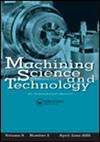液氮作为冷却剂车削Ti-6Al-4V合金性能评价综述
IF 2.6
4区 工程技术
Q2 ENGINEERING, MANUFACTURING
引用次数: 1
摘要
摘要在切削操作过程中,切削液增加了切削区域的载热能力,并减少了切屑-刀具界面的摩擦。它还具有良好的切屑形状、提高产品光洁度和刀具寿命、降低切削力和任何切削操作的功耗等优点。但是,切削液的应用和处理不当造成了一些技术和环境问题。因此,由于对适当冷却和润滑的高要求,许多研究人员热衷于使用低温流体进行冷却。在这种情况下,液氮被认为是一种有效的冷却剂,并且在切削过程中作为切削液是一种更好的润滑剂。有益的结果是通过控制发热区的温度来降低镶片磨损率、机加工表面粗糙度、机加工力、功耗、提高工具寿命和有利的切屑形式,从而降低表面间的附着力。本文综述了在Ti-6Al-4V合金车削过程中使用液氮进行低温冷却的各种方法。基于加工性能,比较了现有液氮方法的特点,并提出了进一步研究的方向。本文章由计算机程序翻译,如有差异,请以英文原文为准。
A review on performance evaluation of liquid nitrogen as coolant in turning Ti-6Al-4V alloy
Abstract During cutting operations, cutting fluids increase heat carrying capacity from the cutting area and reduce friction at the chip-tool interface. It also offers benefits like favorable chip form, enhancement in the finish of product and tool life, lower cutting forces and power consumption during any cutting operations. But the inadequate application of cutting fluids and disposal creates several technical and environmental problems. So, due to the high demand for proper cooling and lubrication, many researchers are keen on cooling using cryogenic fluids. In this, liquid nitrogen is recognized as an effective cooling agent and a better lubricant as a cutting fluid during cutting. Beneficial outcomes are reduced insert wear rate, machined surface roughness, machining forces, power consumption, enhanced tool life and favorable form of chips with liquid nitrogen cooling through controlling the temperature at heat generation zones and thereby reduced adhesion at inter surfaces. This paper reviews the various cryogenic cooling approaches using liquid nitrogen during turning Ti-6Al-4V alloy. The features of existing liquid nitrogen approaches are compared based on the machining performance, and directions for further research are recommended.
求助全文
通过发布文献求助,成功后即可免费获取论文全文。
去求助
来源期刊

Machining Science and Technology
工程技术-材料科学:综合
CiteScore
5.70
自引率
3.70%
发文量
18
审稿时长
6 months
期刊介绍:
Machining Science and Technology publishes original scientific and technical papers and review articles on topics related to traditional and nontraditional machining processes performed on all materials—metals and advanced alloys, polymers, ceramics, composites, and biomaterials.
Topics covered include:
-machining performance of all materials, including lightweight materials-
coated and special cutting tools: design and machining performance evaluation-
predictive models for machining performance and optimization, including machining dynamics-
measurement and analysis of machined surfaces-
sustainable machining: dry, near-dry, or Minimum Quantity Lubrication (MQL) and cryogenic machining processes
precision and micro/nano machining-
design and implementation of in-process sensors for monitoring and control of machining performance-
surface integrity in machining processes, including detection and characterization of machining damage-
new and advanced abrasive machining processes: design and performance analysis-
cutting fluids and special coolants/lubricants-
nontraditional and hybrid machining processes, including EDM, ECM, laser and plasma-assisted machining, waterjet and abrasive waterjet machining
 求助内容:
求助内容: 应助结果提醒方式:
应助结果提醒方式:


